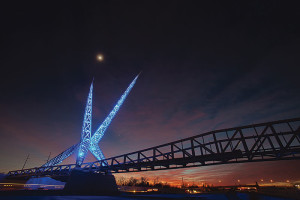SXL was an Award Winner for the SkyDance Bridge project in the 2013 NCSEA Annual Excellence in Structural Engineering awards program (Category – New Bridges & Transportation Structures).
Mayor Cornett described this project as a competition to design a pedestrian bridge of iconic status to serve as a symbol of Oklahoma City. The $6.8M design would literally and figuratively bridge the north and south portions of a new city park, and connect the past with the future of Oklahoma City to travelers of I-40 (formerly Route 66). The result is SkyDance Bridge, a 380-foot-long pedestrian bridge and 197-foot-tall sculpture that spans Interstate 40 near Harvey Avenue south of downtown.

Courtesy of Simon Hurst.
The flight of the Scissor tailed Flycatcher, Oklahoma’s State Bird, perhaps best evokes the shaping forces of the Oklahoma wind. This “skydance” of spring is a V-shaped flight drawn against the sky, marking its signature mating dance. The bird’s distinctive tail feathers demonstrate an evolved necessity to navigate swirling prairie winds. SkyDance Bridge’s soaring architecture was inspired by Oklahoma’s state bird, and reflects the cosmopolitan and vibrant qualities of Oklahoma City.
From October 2008 until June 2011, the design of the bridge evolved, continually adapting to a series of changes including: which design code to design with, changes to governing structural load criteria, dramatic changes to funding sources, a complex client consisting of local, state and federal government agencies and, as time progressed, an accelerated construction schedule.
The architectural design challenges included a true 3-dimensional design which was required due to the lack of symmetry of any element. The 3-D design model was populated with individually unique feathers and supports that were created by an algorithm. None of the feathers, clips or supports were drawn on paper. A totally electronic submission of drawings was required for the individually unique feathers and the individually unique support elements.
The structural design challenges included the fact that no line of symmetry exists in any of the elements. Even the wings have a slight twist or rotation along their length. The 3-D design required that the Architectural and structural model matched not just closely, but exactly. Accurate construction of the SkyDance structural geometry required the use of the structural engineer’s electronic files to ensure fabrication tolerances. Due to its complexity, SkyDance was modeled with two different structural engineering programs to verify the results. To make it more interesting, the bridge is designed under the AASHTO code while the SkyDance structure is designed under the International Building Code (IBC). This meant that the center pier had to meet the requirements of both codes. Due to the height and geometry of SkyDance, the center pier has a very small lateral deflection requirement. But, due to the highway alignment, this pier has a maximum width of 4 feet. To solve this problem, a collection of drilled shafts support the pier, which was designed with post tensioning to help limit the deflections. The design of the concrete filled steel feet and the cold formed steel support elements draw upon research conducted at Oklahoma University’s (OU) Fears Structural Engineering Laboratory by Dr. Ramseyer. Aeroelastic issues (Vortex shedding, flutter, galloping and divergence) had to be addressed. Due to its location over a major highway, FHWA & the Oklahoma DOT required that the SkyDance structure be designed to meet or exceed the fatigue threshold.
The fabrication and construction challenges included the requirement that all fabrication and erection had to be completed in 156 days from the day bids were let. Jigs were required for fabrication of all elements to ensure fit up in the field. These jigs were built using surveying equipment to a precision of 0.01 inch on elements up to 150 feet long. Two of the HSS pipe connections in the SkyDance structure were connecting 11 and 13 elements at each node. The fabricator proposed a change to this highly complex connection, which was approved by the Architects and Structural Engineers as an improvement over the earlier design. These are the cruciform “star” nodes directly over the walkway. The core of these connections consists of solid steel, 14-inch in diameter and 14- and 16-inch thick. Due to accurate design and fabrication, no field modification of any steel element was required. 665 feathers, 1330 clips and 10,640 uniquely located holes align perfectly, with no field modifications. SkyDance was fabricated in 6 pieces (2 wings, 2 legs, 1 body and 1 tail) to minimize field welding. Only 15 welded connections needed to be made in the field
The designers were equally as concerned with crafting a comfortable urban walkway as they were with forging an iconic regional landmark. The thick wooden deck of the bridge deadens the roar of the interstate below and forms a pedestrian-scaled bird’s nest dotted with benches. Vertical notches in the wood railing provide small children with protected lookouts from which to watch cars.
The bridge design and structural engineering was performed by S-X-L. Civil engineering was performed by MKEC engineering. SXL is a collaboration of architects, engineers, university professors and designers that include 5 architects and 2 engineers:
- Architects: Hans Butzer, Stan Carroll, Jeremy Gardner, Ken Fitzsimmons and David Wanzer
- Engineers: Chris Ramseyer and Laurent Massenat
Manhattan Road and Bridge was the general contractor. W&W Steel fabricated the structural steel and Swanda Brothers fabricated the stainless steel feathers.
The SkyDance Bridge has become an important teaching element for Professors Butzer, Carroll and Dr. Ramseyer’s. Several OU classes from both engineering and architecture visited the fabrication and job site during the construction phase. Dr. Ramseyer’s has made SkyDance a central element of his , with his engineering students studying the structural analysis, steel design and bridge engineering design aspects along with fabrication and erection issues.▪
